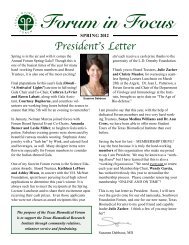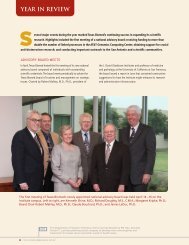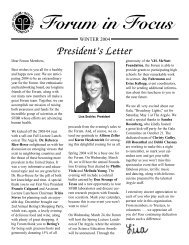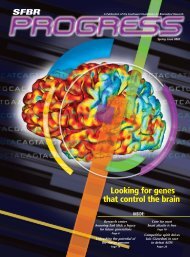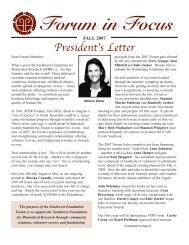Texas Biomed Science Report 2011-2012 - Texas Biomedical ...
Texas Biomed Science Report 2011-2012 - Texas Biomedical ...
Texas Biomed Science Report 2011-2012 - Texas Biomedical ...
Create successful ePaper yourself
Turn your PDF publications into a flip-book with our unique Google optimized e-Paper software.
36<br />
<strong>2011</strong>–<strong>2012</strong> Scientific <strong>Report</strong><br />
“The ultimate goal of biomedical research is to improve the quality of life for all. While fundamental to achieving<br />
this goal, the use of animals in this manner is a privilege. Thus their contribution to this endeavor should never be<br />
diminished, nor their care compromised. As a laboratory animal veterinarian, it is my responsibility to maintain<br />
the highest quality of care for our animal colonies so that we may provide healthy animals to our investigators.”<br />
Melissa A. de la Garza, D.V.M., M.S.<br />
Associate Veterinarian, SNPRC<br />
As the scientific manager for the ABSL-3 Laboratory, de la Garza is<br />
primarily responsible for the daily operations of the facility. This includes<br />
providing leadership for the veterinary technical staff supporting the<br />
facility, as well as serving as lead veterinarian for all research protocols<br />
conducted in the laboratory.<br />
Realizing that establishment of animal models is integral to the<br />
success of any infectious disease program, a staff of veterinarians,<br />
veterinary technicians and pathologists skilled in the care and use of<br />
laboratory animals operate the laboratory. Although our facility is<br />
equipped to manage all species of laboratory animals less than 10<br />
kilograms, we specialize in the use of nonhuman primates.<br />
By selecting a dedicated core staff of veterinary technicians specifically<br />
trained to work with NHPs, the SNPRC staff can assure investigators that<br />
each of their animals and protocols will receive uncompromising care and<br />
attention to detail. Animals are monitored closely throughout the<br />
progression of each study, such that end results will be sound research with<br />
unquestionable integrity. In order to produce high-quality test subjects, it is<br />
imperative that animals be housed in highly enriched environments, with<br />
measures taken to reduce boredom and anxiety. With this goal in mind,<br />
the staff develops relationships with each animal, learning their likes,<br />
dislikes and individual characteristics. The SNPRC staff feels strongly that<br />
the high quality of care for each animal is directly proportional to the high<br />
quality science produced. Care provided to the animals is never<br />
compromised and is without a doubt the center’s most valuable asset.<br />
In the nearly six years that the facility has been operational, the center<br />
has conducted a number of vaccine development and animal model<br />
Publications<br />
• Lieberman MM, Nerurkar VR, Luo H, Cropp B, Carrion R Jr, de la Garza M, Coller BA,<br />
Clements D, Ogata S, Wong T, Martyak T, Weeks-Levy C (2009) Immunogenicity and<br />
protective efficacy of a recombinant subunit West Nile virus vaccine in rhesus monkeys.<br />
Clin Vaccine Immunol 16:1332-7.<br />
• Widman DG, Ishikawa T, Giavedoni LD, Hodara VL, de la Garza M, Montalbo JA, Travassos<br />
Da Rosa AP, Tesh RB, Patterson JL, Carrion R, Jr, Bourne N, Mason PW (2010) Evaluation of<br />
RepliVAX WN, a single-cycle flavivirus vaccine, in a non-human primate model of West Nile<br />
virus infection. Am J Trop Med Hyg 82:1160-67.<br />
• Andrade MCR, Higgins PB, Mattern VI, de la Garza M, Brasky KM, Voruganti VS, Comuzzie<br />
AG. (<strong>2011</strong>) Morphometric variable related to metabolic profile in captive chimpanzees (Pan<br />
troglodytes). Comparative Med 61(5):457-61.<br />
studies using both select and non-select agents. Some of these include the<br />
use of Bacillus anthracis (Ames, Sterne), Francisella tularensis, Japanese<br />
Encephalitis, West Nile Virus, Dengue(1-4) Virus, Mycobacterium<br />
tuberculosis (Mtb), Burkholderia mallei and Burkholderia pseudomallei.<br />
Slated for this year are investigations using Mtb + SIV, in addition to<br />
continuations of some of the above-mentioned studies. Animal models<br />
used thus far include rhesus macaques, cynomologus macaques, rabbits<br />
and mice.<br />
De la Garza shares other clinical and research responsibilities<br />
throughout the Institute. She is routinely called upon to provide clinical<br />
support for the chimpanzee colony. Chimpanzees exhibit disease<br />
states that closely mirror those of humans. As such, they provide an<br />
invaluable model for human disease. Owing to their obvious similarity to<br />
humans, they may develop many of these same conditions through the<br />
natural progression of life, thus requiring thorough clinical monitoring.<br />
SNPRC’s animals are provided the care they need through the expertise<br />
of veterinary staff as well as by interacting with colleagues in human<br />
medicine. Other areas where support is provided by de la Garza include<br />
the ABSL-4 facility as well as the various animal colonies as required.<br />
Staff<br />
Left to right: David<br />
Vandenberg, Laura Rumpf,<br />
George Villanueva,<br />
Melissa de la Garza,<br />
Kathleen Brasky, Alberto Torres,<br />
Matthew Stautzenberger




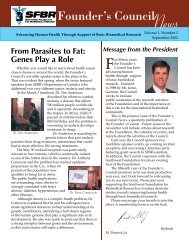
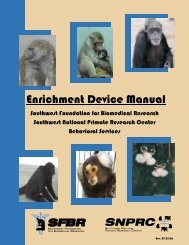
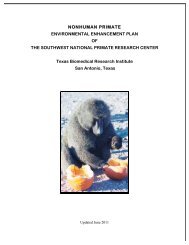
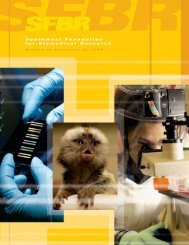
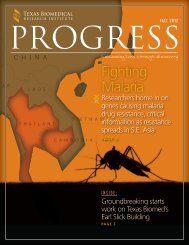
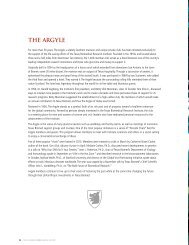
![Vol. 8 No. 2, 2011 [PDF] - Texas Biomedical Research Institute](https://img.yumpu.com/35688099/1/190x245/vol-8-no-2-2011-pdf-texas-biomedical-research-institute.jpg?quality=85)
